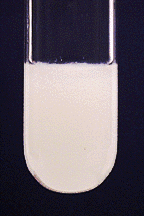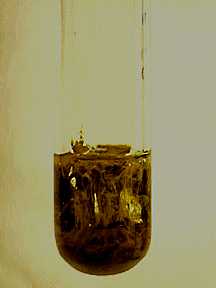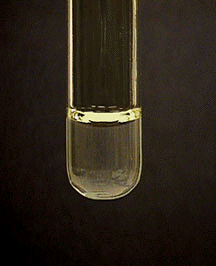Characteristic Reactions of Silver Ions (Ag⁺)
- Page ID
- 97276
- Most common oxidation state: +1
- M.P. 961º
- B.P. 2210º
- Density 10.49 g/cm3
- Characteristics: Silver is a inactive metal. It will react with hot concentrated \(\ce{H2SO4}\), with \(\ce{HNO3}\), and with aqua regia.
- Characteristic reactions of \(\ce{Ag^{+}}\):
Chloride Ion
Soluble chlorides, such as hydrochloric acid, precipitate silver ion as white silver(I) chloride.
\[\ce{Ag^{+}(aq) + Cl^{-}(aq) <=> AgCl(s)} \nonumber \] 
Silver(I) chloride is insoluble in acids, including \(\ce{HNO3}\). The precipitate does dissolve in aqueous ammonia:
\[\ce{AgCl(s) + 2NH3(aq) <=> [Ag(NH3)2]^{+}(aq) + Cl-(aq)} \nonumber \] 
Addition of an acid to this solution, such as \(\ce{HNO3}\), destroys the complex ion and re-precipitates silver(I) chloride:
\[\ce{[Ag(NH3)2]+(aq) + Cl^{-}(aq) + 2H^{+}(aq) <=> AgCl(s) + 2NH4^{+}(aq) } \nonumber \]

Sulfate Ion
No reaction occurs on addition of sulfate ion unless the concentration of \(\ce{Ag^{+}}\) is high, in which case silver(I) sulfate precipitates.
Aqueous Ammonia
Aqueous ammonia precipitates brown \(\ce{Ag2O}\):
\[\ce{2Ag^{+}(aq) + 2NH3(aq) + 2H2O(l) <=> Ag2O(s) + 2NH4^{+}(aq) + H2O(l)} \nonumber \]

The silver(I) oxide precipitate dissolves in excess ammonia to form a colorless complex ion:
\[\ce{Ag2O(s) + 4NH3(aq) + H2O(l) <=> 2[Ag(NH3)2]^{+}(aq) + 2OH^{-}(aq) } \nonumber \]

Sodium Hydroxide
Sodium hydroxide precipitates silver(I) oxide:
\[\ce{2Ag^{+}(aq) + 2OH^{-}(aq) <=> Ag2O(s) + H2O(l)} \nonumber \]

Silver(I) oxide does not dissolve in excess \(\ce{NaOH}\).


